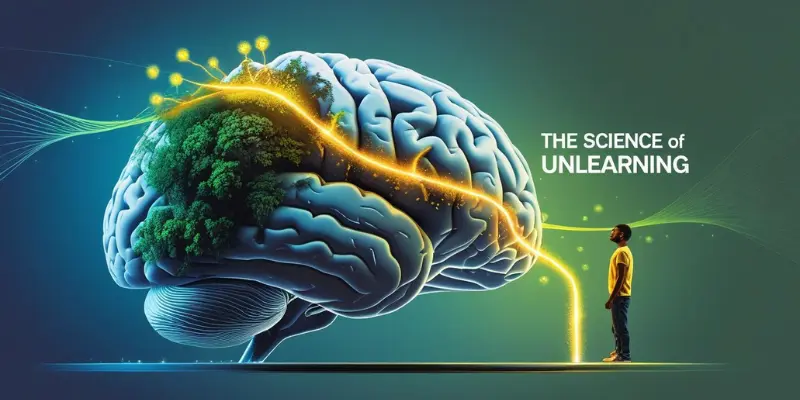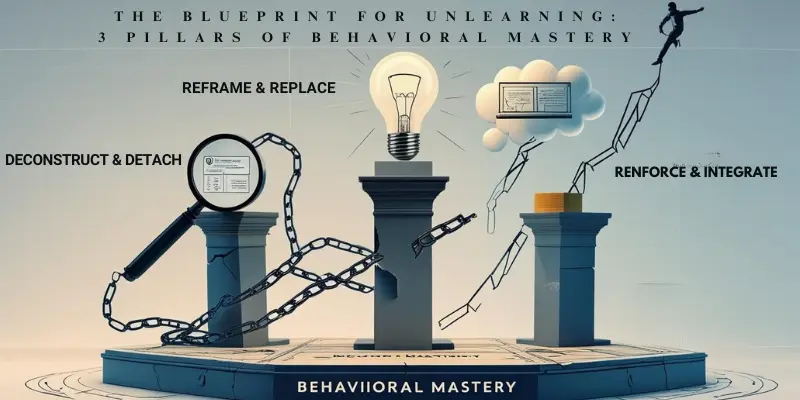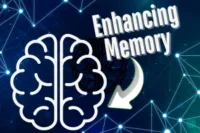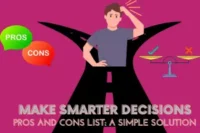“Unlearning” Bad Habits: Strategies for Cognitive Restructuring and Behavioral Change
Published: 20/07/2025
Ever feel like you’re stuck in a loop, repeating the same bad habits over and over again, no matter how hard you try to break free? You promise yourself that this time will be different, yet the next day, you’re back where you started. It’s frustrating, exhausting, and sometimes, it feels like you’ll never escape the cycle.
Bad habits are tough to unlearn because they don’t just reside in your actions—they’re ingrained deeply in your brain. Over time, certain behaviors become automatic, wired into your neural pathways. These habits provide comfort, even if they’re unhealthy or counterproductive. The mind craves familiarity, and so the cycle persists. The more you try to break them, the more they seem to come back, often stronger than before.
But what if there’s a way to unlearn these habits, not just “stop” them? Unlike traditional methods that focus on willpower and sheer force, unlearning is about replacing those old, automatic responses with new, healthier patterns. This guide will introduce you to scientifically-backed, psychologically-informed strategies that will help you master your mind, overcome the old loops, and bring about lasting change. It’s time to transform those deeply rooted habits into new behaviors that truly serve you.
I understand your desire for real, lasting transformation. You’re not just looking for a quick fix; you want a deep, meaningful change in how you think and act. Whether you’re tired of the same old routine or eager to take control of your behavior, this guide is here to offer practical solutions that you can start implementing today.
Beyond Breaking: Understanding the Science of Unlearning
Unlearning is more than just a buzzword—it’s a transformative approach that taps into the fundamental workings of your brain. It goes beyond the simplistic idea of “breaking” a habit and instead focuses on the deeper process of rewiring your brain to replace old patterns with new ones. This section dives into the science behind why unlearning is so powerful and how it works on a neurological and psychological level.

What is “Unlearning” & Why It Matters More Than Just “Breaking”
Unlearning isn’t about simply suppressing or forcing yourself to stop a bad habit. Instead, it involves actively replacing old neural pathways—those automatic responses—with new, healthier patterns. When you “break” a habit, you’re just putting a temporary halt to it, but you’re not addressing the underlying structure that makes the habit automatic. Unlearning is a much deeper process, one where you actively change the neurological structures in your brain.
Think of it like walking through a forest. Over time, you carve a well-worn path that’s easy to follow. This is your habit—efficient, automatic, and ingrained in your routine. Now, instead of simply avoiding the path (which is what “breaking” a habit feels like), you create a new trail that leads you in a different direction. The old path doesn’t disappear instantly, but as you walk the new path more and more, it becomes easier to follow. Eventually, the new trail becomes the default, and the old one fades into the background.
Benefit:
Unlearning leads to more sustainable change because it’s about replacing the old patterns at a deep, neurological level. This creates new, stronger connections in your brain that make the new behavior feel more natural, as opposed to just forcing yourself to fight against the old habit. In contrast, relying on sheer willpower often leads to temporary success, as the old neural pathways remain intact and ready to reactivate when stress or temptation strikes.
The Brain’s Role: Neural Plasticity & Habit Loops
Habits form in the brain through a process called the cue-routine-reward loop. A cue triggers a behavior (the routine), which then results in a reward (the positive outcome). This loop strengthens the neural pathways associated with that behavior. Over time, the habit becomes automatic, and the brain seeks these rewarding behaviors to reinforce the pathways.
The brain’s remarkable neural plasticity allows it to reorganize and form new neural connections, making it possible to change old habits and create new ones. This adaptability is the foundation of unlearning. By intentionally breaking the old loop and inserting a new, healthier routine, you encourage the brain to form a new path that feels just as automatic.
Real-world Example:
A common habit many people struggle with is reaching for their phone the moment they wake up. The cue might be the sound of the alarm, the routine is checking social media or emails, and the reward is the brief dopamine hit from being connected. The more this loop is repeated, the stronger it becomes. To unlearn this habit, one could introduce a new routine, such as immediately getting out of bed to stretch or meditate for a few minutes. Over time, the brain rewires itself, and the new routine becomes the default response to the waking cue.
The Psychology of Resistance: Why Change Is Hard (and How to Face It)
Changing deeply ingrained habits is challenging because your mind and body naturally seek comfort, avoiding the discomfort of change. This resistance can manifest in various forms, such as procrastination, self-doubt, or slipping back into old behaviors, making progress feel slow or impossible.
Common Issues/Troubleshooting:
Changing deeply ingrained habits isn’t easy, and resistance is a normal part of the process. Your mind and body are wired to seek comfort and avoid discomfort. When you try to unlearn a habit, it often triggers discomfort because you’re stepping outside your familiar routine, which feels unsafe to your brain. This resistance can manifest as procrastination, self-doubt, or simply falling back into old patterns.
Psychological barriers such as fear of the unknown, anxiety about failure, or identity being tied to old habits often hold us back. For example, if someone has identified as a “night owl” for years, the idea of waking up earlier can feel like an assault on their very identity. This makes the process of change feel not only difficult but also threatening.
It’s important to remember that resistance isn’t a sign of failure—it’s simply part of the process. Everyone experiences it when they attempt change. Rather than feeling defeated, view it as a natural part of rewiring your brain. Every time you push through resistance, you strengthen the new habit. It’s also helpful to embrace self-compassion during this phase. Change takes time, and setbacks are just a sign that you’re actively learning and growing.
Many people feel trapped by their habits, believing change is impossible. Yet, the science of habit formation offers a more hopeful truth. As acclaimed author Charles Duhigg eloquently states in his groundbreaking book, The Power of Habit:
Change might not be fast and it isn’t always easy. But with time and effort, almost any habit can be reshaped.Charles Duhigg, The Power of Habit
Duhigg’s insight reinforces our core message: while habits are deeply ingrained, they are not your destiny. Understanding their underlying mechanics is the first step toward effective unlearning.
The Blueprint for Unlearning: 3 Pillars of Behavioral Mastery
When it comes to unlearning bad habits, it’s not enough to simply wish them away or try to “break” them. A truly lasting transformation requires a systematic approach, one that involves understanding your behavior, changing the way you think, and making the new behaviors stick. This is where the 3 Pillars of Behavioral Mastery come in: Deconstruct & Detach, Reframe & Replace, and Reinforce & Integrate. Each pillar offers actionable steps that will help you master your mind and make lasting changes to your habits.

Pillar 1: Deconstruct & Detach (Awareness & Disruption)
The first and most critical step to unlearning any bad habit is becoming aware of it. You need to consciously identify what triggers your behavior and understand why it happens. Without awareness, it’s nearly impossible to change anything, as habits are often automatic, running on autopilot.
Specific Advice:
- Identify Triggers (Cues):
The first step is pinpointing what sets your bad habit into motion. Ask yourself:- What time of day does this habit tend to occur?
- Are there particular emotions that trigger the behavior (stress, boredom, etc.)?
- Is there a specific location or group of people that sparks the habit?
- Observe Without Judgment:
Mindfulness is a powerful tool for breaking free from bad habits. Instead of trying to stop the behavior immediately, practice observing it without judgment. Simply notice the habit as it happens and acknowledge it—this brings the unconscious behavior to your awareness. A simple exercise is to pause for a moment when you feel the urge to engage in the habit. Observe your thoughts and physical sensations without acting on them. This moment of pause can create space between the urge and your response. - Disrupt the Pattern:
Once you’ve become aware of the triggers and patterns, it’s time to disrupt them. Small, immediate actions can break the flow of the habitual behavior. This could mean:- Waiting for 10 minutes before acting on the impulse to eat junk food or check your phone.
- Changing your location (e.g., stepping outside for a walk) when the urge hits.
- Taking a few deep breaths to reset your mind and body.
Real-world Example:
Take Sarah, who noticed that she would reach for snacks whenever she felt stressed at work. By identifying the trigger (stress from meetings), she started taking 10-minute breaks to walk around the office instead of heading to the break room. This small change helped disrupt the automatic flow of her habit.
Pillar 2: Reframe & Replace (Cognitive Restructuring & New Routines)
At the heart of lasting behavioral change is the ability to reframe the way you think about your habits and replace them with healthier routines. This is the mindset shift—moving from simply breaking the habit to actively rewiring your thought patterns and behaviors.
Specific Advice:
- Cognitive Restructuring Techniques:
Often, bad habits are supported by negative self-talk or limiting beliefs (e.g., “I’m always going to be this way” or “I can’t change”). To change these patterns, you need to reframe these thoughts.- Instead of saying, “I can’t do this,” tell yourself, “I haven’t learned this yet, but I will.”
- Change “I always fail at this” to “Every attempt brings me closer to success.”
- “If-Then” Planning:
An effective way to prepare for moments when old triggers appear is to use “If-Then” planning. This is a simple technique where you create an action plan for how to respond when the habit trigger arises. For example:- “If I feel stressed, then I will take five deep breaths and then walk outside for five minutes.”
- “If I feel the urge to eat junk food, then I will grab a healthy snack instead.”
- Substitute Behaviors:
Every bad habit serves some underlying need or desire. Instead of eliminating the habit, find a healthier behavior that meets that same need.- If you snack out of boredom, replace it with drinking water or chewing gum.
- If you check your phone due to habit, replace it with reading a chapter of a book.
Real-world Example:
John had a nervous habit of biting his nails during stressful meetings. Instead of simply trying to stop, he reframed the thought, “I’m anxious, but I can handle it,” and replaced the behavior by squeezing a stress ball whenever the urge hit. Over time, his new behavior became just as automatic as the old one.
Pillar 3: Reinforce & Integrate (Consistency & Environment Design)
The final pillar is all about reinforcing the new behavior and integrating it into your life consistently. It’s not enough to have a breakthrough once or twice—you need to make your new behaviors automatic and ingrained. This is where environment design and accountability come into play.
Specific Advice:
- Environment Design:
Your surroundings play a crucial role in reinforcing your behaviors. To make the new habits stick, you need to design your environment in a way that supports your desired behaviors and makes the old ones harder to reach.- Remove temptations (e.g., keep junk food out of the house, or delete distracting apps from your phone).
- Set up cues for new behaviors (e.g., lay out workout clothes the night before to remind yourself to exercise).
- Reward Systems:
Positive reinforcement is a powerful tool in creating lasting change. Celebrate small victories by rewarding yourself for staying consistent with your new habits.- For instance, after a week of exercising regularly, treat yourself to a fun activity or a special meal.
- Accountability Partners:
Share your goals with someone you trust. Having an accountability partner keeps you motivated and provides support when you’re struggling. Whether it’s a friend, a family member, or a coach, knowing someone is checking in on you increases your commitment to the process. - Small Wins & Consistency:
Rather than aiming for perfection, focus on small, consistent actions. Progress may be slow, but it’s important to show up every day and keep building the new habit. Over time, the consistency will make the new behavior feel as automatic as the old one.
Real-world Example:
Emily wanted to stop checking her phone first thing in the morning. To do this, she moved her phone to another room at night, making it harder to grab it upon waking. She also set a small reward—after two weeks of not checking her phone, she treated herself to a weekend getaway.
These 3 Pillars of Behavioral Mastery—Deconstruct & Detach, Reframe & Replace, and Reinforce & Integrate—are the keys to lasting change. By gaining awareness, shifting your thought patterns, and making the new behavior stick, you can truly master your mind and unlearn those bad habits for good.
Expert Insights: Overcoming Common Pitfalls & Accelerating Progress
Unlearning bad habits is a powerful journey, but it’s not always a straight path. There are several common mistakes people make along the way, as well as proven strategies to help you overcome these obstacles faster. This section will provide expert insights to help you avoid those pitfalls and accelerate your progress toward lasting change.
Common Mistakes When Trying to Unlearn Habits
As you embark on the process of unlearning, it’s crucial to be aware of the common mistakes that can slow down your progress or even set you back. Here are some of the biggest pitfalls and why they tend to fail:
Mistake 1: Relying Solely on Willpower (and Why It Fails)
Willpower is often seen as the key to overcoming bad habits. However, relying only on sheer determination is a flawed approach. The truth is that willpower is finite—it can get drained quickly, especially when faced with temptation or stress. Additionally, willpower doesn’t address the root causes of your habits. Without addressing the underlying triggers and neural pathways, willpower alone won’t create lasting change.
Why It Fails: Willpower can only go so far, and when it runs out, your old habits are likely to resurface. Without proper strategies in place to replace the old behavior, you’ll be relying on an unsustainable resource.
Mistake 2: Trying to Change Too Much at Once (Overwhelm)
It’s tempting to overhaul your entire routine and mindset in one go, but attempting to change multiple habits at once can quickly become overwhelming. The result? You may abandon the effort altogether. Focused, incremental changes are more effective.
Why It Fails: Trying to change too much at once increases the likelihood of burnout. Instead of tackling every habit, start with one and make it a consistent part of your routine before moving on to others.
Mistake 3: Not Forgiving Relapses (Leading to Giving Up)
Relapses are a normal part of the unlearning process. Yet, many people treat them as personal failures. This mindset leads to frustration and discouragement, which often causes individuals to give up entirely. In truth, setbacks are opportunities for growth and refinement, not signals to quit.
Why It Fails: When you don’t forgive yourself for relapses, you fall into a negative cycle of shame and defeat. The key is to view each relapse as a lesson—what can you learn from it to strengthen your approach next time?
Mistake 4: Ignoring the Underlying Need/Emotion the Habit Serves
Every bad habit fulfills an underlying emotional or psychological need. Whether it’s stress relief, boredom, or social acceptance, ignoring this need can make the habit harder to unlearn. Without addressing the root cause, you might simply swap one bad habit for another, without achieving lasting change.
Why It Fails: Without identifying the emotional trigger behind the habit, you’re more likely to fall back into the same pattern. Understanding the deeper need the habit serves allows you to replace it with a healthier, more effective response.
Pro-Tips for Accelerated Unlearning
Now that we’ve addressed the common mistakes, let’s look at some expert tips that can accelerate your progress and make the unlearning process more effective.
Mindfulness & Meditation: How These Practices Build Awareness and Self-Control
Mindfulness and meditation are powerful tools for building awareness and self-control. These practices help you gain clarity on the triggers and patterns that fuel your habits. Through mindfulness, you can create a space between the urge to act on a habit and the actual behavior, allowing you to make more conscious choices.
How to Use It:
- Start with 5-10 minutes of meditation each day.Use mindfulness techniques to stay present when the urge to engage in a bad habit arises.Focus on your breath and observe the sensations and emotions without judgment.
Visualization: Using Mental Rehearsal to Solidify New Pathways
Visualization is a powerful cognitive tool that helps your brain rehearse new behaviors. By vividly imagining yourself engaging in a new, healthier behavior, you reinforce the neural pathways that support it. This mental rehearsal helps bridge the gap between the new behavior and your physical actions, making it easier for the new habit to take hold.
How to Use It:
- Spend a few minutes each day visualizing yourself successfully navigating situations where you would typically engage in the old habit.Picture yourself calmly handling the situation with the new behavior in mind.
- Professional Support: When to Consider Coaching or Therapy for Deeply Ingrained Habits
Sometimes, unlearning a habit requires more than just personal effort. For deeply ingrained habits, particularly those linked to trauma, addiction, or other psychological issues, professional support can be immensely valuable. A therapist or coach can provide the tools, techniques, and emotional support needed to dig deeper and break the cycle. When to Consider Professional Support:- When habits are tied to emotional trauma or deeply rooted psychological issues.
- When self-help methods aren’t yielding sustainable results.
- When you need accountability or a structured plan for change.
- The Power of Identity Shift: How Changing “Who You Are” Can Drive “What You Do”
Identity plays a significant role in behavior change. People often cling to their habits because they tie them to their self-concept (e.g., “I’m the kind of person who smokes” or “I’m always late”). To unlearn a habit effectively, you need to shift your identity. Instead of focusing on the behavior itself, change the way you think about yourself. How to Use It:- Change your self-talk: Instead of saying “I’m trying to quit smoking,” say “I’m a non-smoker.”
- Reinforce this new identity by consistently acting in alignment with it.
Beyond just changing behaviors, true mastery often comes from shifting your self-perception. Understanding this ‘identity shift’ can dramatically accelerate your unlearning journey. As James Clear, author of the bestselling Atomic Habits, powerfully illustrates:
Every action you take is a vote for the type of person you wish to become. No single instance will transform your beliefs, but as the votes build up, so does the evidence of your new identity.James Clear, Atomic Habits
This powerful principle means that every conscious choice to unlearn an old habit and adopt a new behavior isn’t just an isolated act; it’s a statement about who you are becoming. Focus on accumulating those ‘votes’ daily.
By avoiding common mistakes and implementing these expert strategies, you can accelerate your progress and move closer to truly mastering your mind and behaviors. Change doesn’t happen overnight, but with these insights, you’ll be equipped with the tools to make lasting, sustainable transformations.
Embrace Transformation: Your Next Steps to Habit Mastery
Unlearning bad habits is not just about “stopping” old behaviors; it’s about rewiring your brain to adopt new, healthier patterns. By following the 3 Pillars of Behavioral Mastery—Deconstruct & Detach, Reframe & Replace, and Reinforce & Integrate—you can break free from the automatic loops of your past habits and create lasting change. The key to success lies in consistent effort. Through awareness, thought reframing, and maintaining your new behaviors, transformation is entirely possible.
Lasting behavioral change is achievable for anyone. By mastering your mind and understanding the deeper mechanisms behind your habits, you can replace old patterns with new, empowering behaviors that serve your goals. The power to change is in your hands—you just need the right tools and mindset.
Ready to truly master your mind and build the life you deserve? Start implementing these unlearning strategies today! Share your first step in the comments below, or explore our other guides for deeper transformation. Take that first step now—your future self will thank you for it.
Unlocking Clarity: Your Most Common Questions on Habit Transformation Answered
It means actively replacing old, automatic thought and behavior patterns with new, positive ones, rather than just trying to stop the old habit.
Bad habits are deeply wired neural pathways in your brain. They’re often automatic responses to specific triggers and provide a perceived reward, making them resistant to simple willpower.
You primarily replace bad habits. Your brain often doesn’t “delete” old pathways, but rather forms stronger, new pathways for different behaviors, effectively making the old ones irrelevant.
There’s no fixed timeline. It varies greatly by habit and individual, often ranging from a few weeks to several months of consistent effort. Focus on consistency, not speed.
It’s the cycle: a cue (trigger) prompts a routine (the habit behavior), which then leads to a reward (the positive feeling or outcome the brain seeks).
Cognitive restructuring teaches you to identify and challenge negative or unhelpful thought patterns that fuel bad habits, replacing them with more realistic and supportive thoughts.
For most people, focusing on one or two habits at a time is more effective. This allows you to dedicate enough mental energy and consistency for lasting change without feeling overwhelmed.
Your environment is crucial! It contains many triggers for your habits. Modifying your surroundings to remove old triggers and introduce new cues for desired behaviors can significantly aid unlearning.
Relapses are common and a normal part of the change process. It does not mean you failed. It’s a learning opportunity to understand what triggered the relapse and adjust your strategies. Get back on track immediately.
Mastering your mind involves increasing self-awareness, emotional regulation, and cognitive control. These skills are essential for identifying triggers, reframing thoughts, and consciously choosing new behaviors over old ones.

- Be Respectful
- Stay Relevant
- Stay Positive
- True Feedback
- Encourage Discussion
- Avoid Spamming
- No Fake News
- Don't Copy-Paste
- No Personal Attacks



- Be Respectful
- Stay Relevant
- Stay Positive
- True Feedback
- Encourage Discussion
- Avoid Spamming
- No Fake News
- Don't Copy-Paste
- No Personal Attacks





